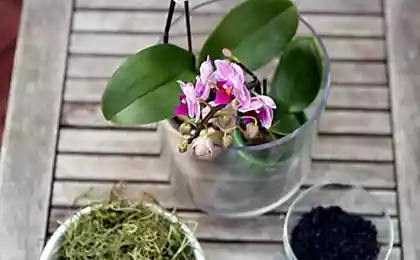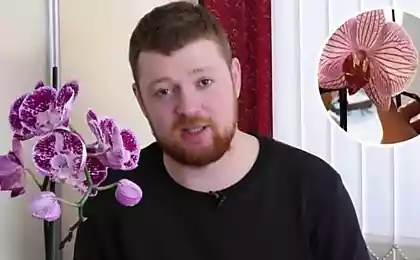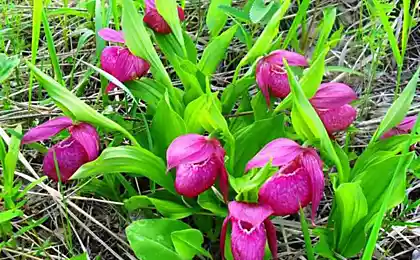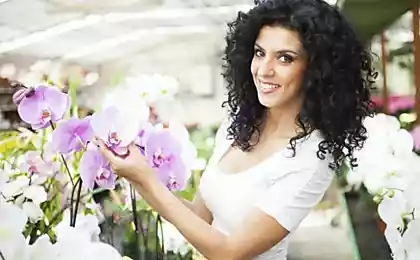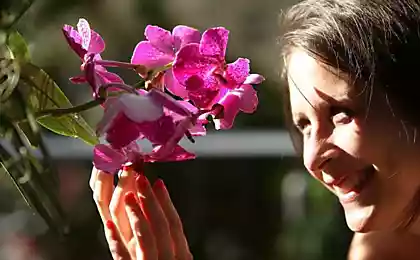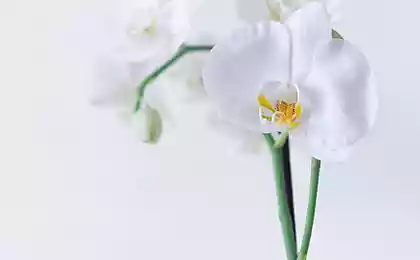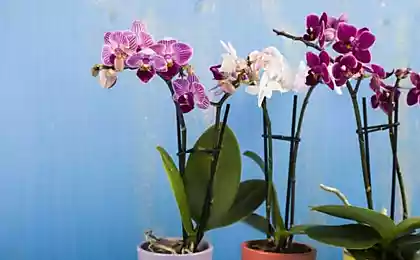530
The reproduction of Phalaenopsis orchids: what you need to know
The reproduction of Phalaenopsis in the home is considered to be a complex matter, partly risky (division of the plant into two parts), is often unpredictable and unreliable (stimulation with special hormones buds on the peduncle). And yet, I the last few years, successfully grown children on the stems of these orchids without particular difficulties and without the use of hormonal pastes.
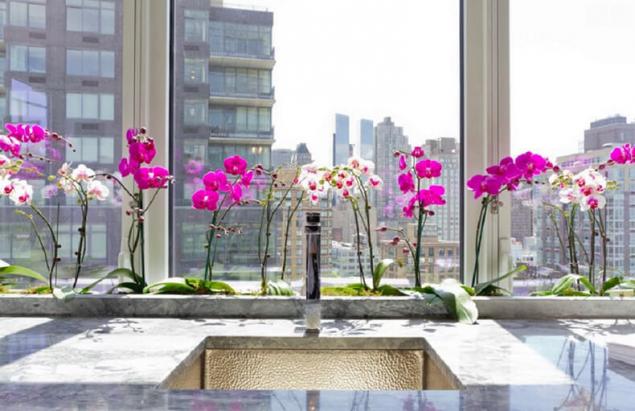
Acquainted with orchids 7 years ago, I took two decisions: first, to contain these plants naturally rooms and a balcony, avoiding possible orchidarium and artificial dosvechivaniya. Second — keep a diary-a calendar, as detailed as possible.
Adhere to these principles and now. Orchidarium backlight was still built, but it is used only as the "intensive care unit". Diary for orchids'm still. Now it is less detailed and better structured. These records are not helped to understand the cause of certain behaviours of plants. It happened in the case of Phalaenopsis.
By purchasing these luxurious beauties, I wish they bloomed all year round! Well, at least twice a year. I have observed this behavior of these plants at her friend. My Phalaenopsis every spring just got babies. When it happened in the third year, I reread all the entries in the diary.
Analyzing the received surprisingly simple scheme that completely fit into the natural rhythm of life of these plants. Three springs tested this method and were consistently positive result, which I want to tell growers that wish to get a baby Phalaenopsis.
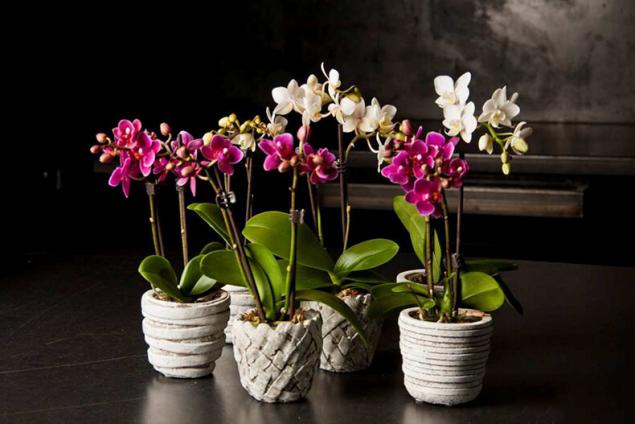
It's pretty simple. The only serious limitation: in the window containing the Phalaenopsis, should several hours a day to look into the sun. North and North-West are not suitable.
Season: from second half of February until mid-June. Requirements for plants: adult specimen with a good root system and at least 4 large leaves. Of course, the Phalaenopsis should be faded. That is to have fresh (not older than one and a half years) stems, clipped to the top of "sleeping" buds. Well, if the Orchid rested after flowering a couple of months.
I tried the three options that give the desired result. In all three cases, night temperatures of 16-18 degrees. Irrigation, consequently, is very scarce or not watered at all for 10-15 days. Everything is done so well as to stimulate flowering. You need to "Wake up" the "sleeping" flower Bud, and then will play the role of the spring sun.
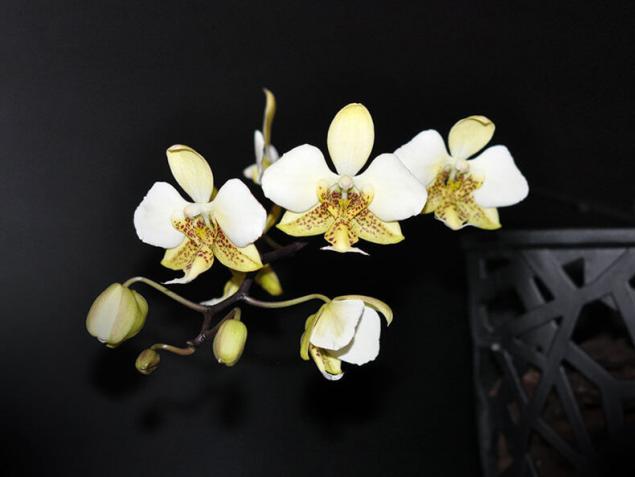
The first option. February-March, Western window, the sun from 15 o'clock. At this time of year the night on the windowsill is still cold. The difference in day and night temperatures on clear days significant. The flower stalks of Phalaenopsis are heated by solar rays for at least an hour a day. On the leaves of some plants appear purple plaque, the so-called "tan", but pretty weak, not dangerous. This option is the most successful. Young Phalaenopsis cut from the peduncle in June. The mother plant has time to relax (often to grow a leaf) and the autumn full of energy and ready to bloom.
A variant of the second. April-beginning of may. Stand plants on balcony West orientation as your day and night temperature. The temperature difference at this time is also significant. Phalaenopsis receive the direct rays of the sun from 7 am to 11 am. Even when the location of 120 cm from the glass they have a "tan", sometimes quite strong. Hybrids with dark leaves are particularly acute. Use caution, because the health of the plant is much more important produce offspring. Possible shade leaves (not the stalks) and other large plants. For example, Anthurium. This option inconvenient fact. there is need to carefully monitor the weather forecast and stop watering 3-4 days before the cold snap.
The third option. Similar to number two. The most difficult and unreliable, because only a period of cooling from late may to mid-June. Leave the plants on the balcony, shade them in this case carefully. This something is the trick: to exclude overheating of the leaves of Phalaenopsis, and is quite warm it stalks in the sun. If the Orchid gives offspring in this period, it is likely that before the end of the year, it will not bloom. She'll need a rest. Usually after one to two weeks drying of the soil in the pot of Orchid notice an increase the kidneys, and a week takes place the first tiny (0.5 cm) leaf. The number of children on the same plant impossible to predict. It happens that some hybrids are "issued" and give young seedlings simultaneously from a single peduncle. But most often aktiviziruyutsya only one, the top Bud.

Since then, the Phalaenopsis clean in a warmer and shaded place. It is important for the subsequent autumn flowering. The plant starts to feed when watering and actively on the leaves. Fertilizer at this time very necessary, but to increase the frequency of nutrient for soil or their concentration is not necessary.
Noticed that even a very strong instances, if you grow a sheet at a time with offspring, this piece, whatever you feed the plant, always turns out smaller and weaker than the previous one. Phalenopsis gives up everything "for the children".
Intensive feeding on leaves allow you to correct the situation, and the young plant in this case increases biomass rapidly. First, growing three leaf (occasionally two), one more than the other, then begins a rapid rooting. At this point, cook a pot of bark for Phalaenopsis young. Pot necessarily transparent. It is easier to determine the need for irrigation, to monitor the growth of the roots and eliminate them to rot.
The first time I have compiled a substrate for toddlers in the same proportions as for adult plants, always added sphagnum moss. Now I use only pine bark (particle size 0.5-1 cm). Sphagnum moss are eliminated in full.
The fact that the young plants the first year necessarily kept in the greenhouse with high humidity, the moss gives excessive moisture in the pot and the roots quickly rot. At least half of the necessary bark for the new plants take from the pot adult Phalaenopsis (optional was crushed). This greatly improves the survival rate of children, because in this substrate already has everything necessary for life of plant organisms.
When the planting site is prepared, decide to remove decus peduncle or not. Some hybrids the stalks retain flexibility, or Phalaenopsis grown in a hanging basket and the stem does not tie. While it bends and hangs below the rim of the pot. Then the little Orchid does not cut off, but attract her to the pot and secured with wire.
The first stems securely fix the pulling wire to the edge of the pot adult parent plant. In this case, you don't need a greenhouse-orchidarium, and a small Phalaenopsis is developing especially quickly. This option is most preferable, but rare.
Much more sturdy flower stalks rise high above the plant. Then wait a few days until the roots have kids will grow to 2-4 cm and cut it together with a piece of peduncle longer than 1 cm. Slices treated with powder of fundazol. Planted and placed in a greenhouse.
Did the baby develops for about a year. During this time, grow two or three leaves and a few roots should reach the bottom of the pot. After that, the plant can be kept open on the windowsill as an adult. With good care each leaf grows bigger, and a year later the young plant is able to bloom.

On the mother plant the flower stalk can be completely cut off. No offspring, no flowers, he never will. Twice when I've missed the point, the roots grew too long, and it was impossible to put in the pot without breaking. Then, left kids on the spike and observed the following picture: growing a huge "beard" roots, and the leaves do not grow at all.
The fall in natural cold and reducing irrigation produces small Phalaenopsis stems 10-12 cm and blooms one or two flowers are the normal size. In this scenario, it is best to wait until the end of flowering and the appearance of a new leaf. At the same time begin to grow roots.
It is important to cut a little Orchid, not having missed the start of rooting. These young roots and will be major, and long aerial roots will gradually die back in the pot, so they can be trimmed to a comfortable length. The sections necessarily treated carbon powder or fundazol.
This blossoming piece of work should also grow in the greenhouse for at least a year. In the proposed method, the key point I think the heat spike after you Wake up the kidneys. The sun at the same time — most affordable, free "heating device", not able to burn the stems. I had another interesting experience, confirming the importance of heating.
Decembrist in your home: features of care and the secrets of flowering
How to root cuttings from houseplants
It can be concluded" that for quick growth of offspring the Phalaenopsis is preferable to provide the temperature from +25 to + 30 deg. The lower the temperature, the slower developing kids. Of the eight growing my Phalaenopsis hybrid I was not able to propagate only one.published
Author: Tamara Wahnich
Source: www.flowersweb.info/orchids/experience/phalenopsis.php

Acquainted with orchids 7 years ago, I took two decisions: first, to contain these plants naturally rooms and a balcony, avoiding possible orchidarium and artificial dosvechivaniya. Second — keep a diary-a calendar, as detailed as possible.
Adhere to these principles and now. Orchidarium backlight was still built, but it is used only as the "intensive care unit". Diary for orchids'm still. Now it is less detailed and better structured. These records are not helped to understand the cause of certain behaviours of plants. It happened in the case of Phalaenopsis.
By purchasing these luxurious beauties, I wish they bloomed all year round! Well, at least twice a year. I have observed this behavior of these plants at her friend. My Phalaenopsis every spring just got babies. When it happened in the third year, I reread all the entries in the diary.
Analyzing the received surprisingly simple scheme that completely fit into the natural rhythm of life of these plants. Three springs tested this method and were consistently positive result, which I want to tell growers that wish to get a baby Phalaenopsis.

It's pretty simple. The only serious limitation: in the window containing the Phalaenopsis, should several hours a day to look into the sun. North and North-West are not suitable.
Season: from second half of February until mid-June. Requirements for plants: adult specimen with a good root system and at least 4 large leaves. Of course, the Phalaenopsis should be faded. That is to have fresh (not older than one and a half years) stems, clipped to the top of "sleeping" buds. Well, if the Orchid rested after flowering a couple of months.
I tried the three options that give the desired result. In all three cases, night temperatures of 16-18 degrees. Irrigation, consequently, is very scarce or not watered at all for 10-15 days. Everything is done so well as to stimulate flowering. You need to "Wake up" the "sleeping" flower Bud, and then will play the role of the spring sun.

The first option. February-March, Western window, the sun from 15 o'clock. At this time of year the night on the windowsill is still cold. The difference in day and night temperatures on clear days significant. The flower stalks of Phalaenopsis are heated by solar rays for at least an hour a day. On the leaves of some plants appear purple plaque, the so-called "tan", but pretty weak, not dangerous. This option is the most successful. Young Phalaenopsis cut from the peduncle in June. The mother plant has time to relax (often to grow a leaf) and the autumn full of energy and ready to bloom.
A variant of the second. April-beginning of may. Stand plants on balcony West orientation as your day and night temperature. The temperature difference at this time is also significant. Phalaenopsis receive the direct rays of the sun from 7 am to 11 am. Even when the location of 120 cm from the glass they have a "tan", sometimes quite strong. Hybrids with dark leaves are particularly acute. Use caution, because the health of the plant is much more important produce offspring. Possible shade leaves (not the stalks) and other large plants. For example, Anthurium. This option inconvenient fact. there is need to carefully monitor the weather forecast and stop watering 3-4 days before the cold snap.
The third option. Similar to number two. The most difficult and unreliable, because only a period of cooling from late may to mid-June. Leave the plants on the balcony, shade them in this case carefully. This something is the trick: to exclude overheating of the leaves of Phalaenopsis, and is quite warm it stalks in the sun. If the Orchid gives offspring in this period, it is likely that before the end of the year, it will not bloom. She'll need a rest. Usually after one to two weeks drying of the soil in the pot of Orchid notice an increase the kidneys, and a week takes place the first tiny (0.5 cm) leaf. The number of children on the same plant impossible to predict. It happens that some hybrids are "issued" and give young seedlings simultaneously from a single peduncle. But most often aktiviziruyutsya only one, the top Bud.

Since then, the Phalaenopsis clean in a warmer and shaded place. It is important for the subsequent autumn flowering. The plant starts to feed when watering and actively on the leaves. Fertilizer at this time very necessary, but to increase the frequency of nutrient for soil or their concentration is not necessary.
Noticed that even a very strong instances, if you grow a sheet at a time with offspring, this piece, whatever you feed the plant, always turns out smaller and weaker than the previous one. Phalenopsis gives up everything "for the children".
Intensive feeding on leaves allow you to correct the situation, and the young plant in this case increases biomass rapidly. First, growing three leaf (occasionally two), one more than the other, then begins a rapid rooting. At this point, cook a pot of bark for Phalaenopsis young. Pot necessarily transparent. It is easier to determine the need for irrigation, to monitor the growth of the roots and eliminate them to rot.
The first time I have compiled a substrate for toddlers in the same proportions as for adult plants, always added sphagnum moss. Now I use only pine bark (particle size 0.5-1 cm). Sphagnum moss are eliminated in full.
The fact that the young plants the first year necessarily kept in the greenhouse with high humidity, the moss gives excessive moisture in the pot and the roots quickly rot. At least half of the necessary bark for the new plants take from the pot adult Phalaenopsis (optional was crushed). This greatly improves the survival rate of children, because in this substrate already has everything necessary for life of plant organisms.
When the planting site is prepared, decide to remove decus peduncle or not. Some hybrids the stalks retain flexibility, or Phalaenopsis grown in a hanging basket and the stem does not tie. While it bends and hangs below the rim of the pot. Then the little Orchid does not cut off, but attract her to the pot and secured with wire.
The first stems securely fix the pulling wire to the edge of the pot adult parent plant. In this case, you don't need a greenhouse-orchidarium, and a small Phalaenopsis is developing especially quickly. This option is most preferable, but rare.
Much more sturdy flower stalks rise high above the plant. Then wait a few days until the roots have kids will grow to 2-4 cm and cut it together with a piece of peduncle longer than 1 cm. Slices treated with powder of fundazol. Planted and placed in a greenhouse.
Did the baby develops for about a year. During this time, grow two or three leaves and a few roots should reach the bottom of the pot. After that, the plant can be kept open on the windowsill as an adult. With good care each leaf grows bigger, and a year later the young plant is able to bloom.

On the mother plant the flower stalk can be completely cut off. No offspring, no flowers, he never will. Twice when I've missed the point, the roots grew too long, and it was impossible to put in the pot without breaking. Then, left kids on the spike and observed the following picture: growing a huge "beard" roots, and the leaves do not grow at all.
The fall in natural cold and reducing irrigation produces small Phalaenopsis stems 10-12 cm and blooms one or two flowers are the normal size. In this scenario, it is best to wait until the end of flowering and the appearance of a new leaf. At the same time begin to grow roots.
It is important to cut a little Orchid, not having missed the start of rooting. These young roots and will be major, and long aerial roots will gradually die back in the pot, so they can be trimmed to a comfortable length. The sections necessarily treated carbon powder or fundazol.
This blossoming piece of work should also grow in the greenhouse for at least a year. In the proposed method, the key point I think the heat spike after you Wake up the kidneys. The sun at the same time — most affordable, free "heating device", not able to burn the stems. I had another interesting experience, confirming the importance of heating.
Decembrist in your home: features of care and the secrets of flowering
How to root cuttings from houseplants
It can be concluded" that for quick growth of offspring the Phalaenopsis is preferable to provide the temperature from +25 to + 30 deg. The lower the temperature, the slower developing kids. Of the eight growing my Phalaenopsis hybrid I was not able to propagate only one.published
Author: Tamara Wahnich
Source: www.flowersweb.info/orchids/experience/phalenopsis.php
